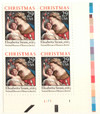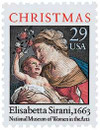
# 2871 - 1994 29c Traditional Christmas: Madonna and Child
U.S. #2871
1994 29¢ Madonna and Child
Sheet Stamp
Traditional Christmas
- First Traditional Christmas stamp with artwork by a woman, Elisabetta Sirani
- 28th Traditional Christmas stamp
Stamp Category: Commemorative
Set: Traditional Christmas
Value: 29¢, rate for first-class mail
First Day of Issue: October 20, 1994
First Day City: Washington, DC
Quantity Issued: 518,500,000
Printed by: Bureau of Engraving and Printing
Printing Method: Lithographed & Engraved
Format: Panes of 50 in sheets of 300
Perforations: 10.1 x 10
Why the stamp was issued: For use on holiday mail
About the stamp design: The stamp pictures a 34-inch by 27.5-inch painting titled, Virgin and Child by Italian painter Elisabetta Sirani, dated 1663. Use of the Sirani painting for this stamp was suggested to the USPS by Glenn Everett after seeing it at the National Museum of Women in the Arts in Washington, DC. Everett said that the moment he saw the painting, he thought “This is a beautiful and very lively picture that would be wonderful for the Christmas stamp.” The stamp was designed by Bradbury Thompson and John Boyd.
Special design details: The National Museum of Women in the Arts had requested their full name be included on the stamp. In order to make the type large enough to be legible, “The” at the beginning had to be left off.
First Day City: Washington, DC – at the National Museum of Women in the Arts, where the painting hangs
About the Christmas Series: By the early 1960s, the US Post Office was receiving 1,000 letters a year (for several years) asking for a Christmas-themed stamp to frank their holiday mail. The idea was approved and the US issued its first Christmas stamp on November 1, 1962.
The stamp was wildly popular, featuring popular holiday decorations of a wreath and candles. The Post Office Department had expected there would be a great demand for the issue, so they printed 350 million stamps – the largest print run for a special stamp up to that time. Those 350 million stamps sold out quickly, leading the Bureau of Engraving and Printing to produce more stamps – reaching over 860 million by the end of the year.
While the Christmas stamp was very popular, it wasn’t without its detractors. Some didn’t agree with the idea of the post office issuing a stamp honoring a religious holiday. Others wanted Christmas stamps that were more religious. The Post Office would continue to issue Christmas stamps in the coming years that featured the National Christmas Tree, seasonal plants, and an angel in 1965. The angel was considered less controversial because angels are included in many religions, not just Christianity.
In 1966, the Post Office came up with a plan to produce Christmas stamps utilizing classic paintings of the Madonna and Child. These stamps wouldn’t violate the separation of church and state because they were a celebration of culture. On November 1, 1966, they issued the first US Madonna and Child stamp in Christmas, Michigan. The stamp featured the 15th century painting, Madonna and Child with Angels, by Flemish painter Hans Memling.
That stamp was very popular and over 1.1 billion were printed. The same design was used again the following year, however, the 1967 stamp was larger and showed more of the painting. The stamp’s continued popularity led the Post Office to issue another traditional Christmas stamp in 1968, this time picturing the Angel Gabriel. For the 1969 issue, they reverted back to the non-religious theme, with a stamp picturing a painting called Winter Sunday in Norway, Maine.
The Post Office made a big change in 1970. To keep people in both camps happy, they issued one traditional Christmas stamp, picturing a classic painting of the Nativity, plus a block of four picturing Christmas toys. That decision proved popular and they have continued to issue stamps with both traditional and contemporary Christmas themes ever since.
History the stamp represents:
Even in 17th-century Bologna, Italy, which was known for its intellectual and artistic women, the talent of Elisabetta Sirani was considered unusual. Remarkably gifted, young Sirani learned to paint in her father’s studio, where she studied under Guido Reni, one of the most influential painters of her day.
Sirani went on to develop her own individual style, which even today continues to stand out among other seventeenth-century art. Her considerable talent and fresh approach to traditional themes made her works sought after and highly praised by her contemporaries. Although her career lasted only ten short years, she created more than 190 works of art, the majority of which were produced for private patrons. Completed just two years before her death, her oil painting of the Virgin and Child has been admired not only for its sweet and intimate scene, but also for its technical mastery.
Sirani’s sudden death in 1665 at age 27 remains a mystery. So beloved was she, that the entire city of Bologna went into mourning, arranging a magnificent funeral for her. As a final tribute, she was buried next to Guido Reni.
U.S. #2871
1994 29¢ Madonna and Child
Sheet Stamp
Traditional Christmas
- First Traditional Christmas stamp with artwork by a woman, Elisabetta Sirani
- 28th Traditional Christmas stamp
Stamp Category: Commemorative
Set: Traditional Christmas
Value: 29¢, rate for first-class mail
First Day of Issue: October 20, 1994
First Day City: Washington, DC
Quantity Issued: 518,500,000
Printed by: Bureau of Engraving and Printing
Printing Method: Lithographed & Engraved
Format: Panes of 50 in sheets of 300
Perforations: 10.1 x 10
Why the stamp was issued: For use on holiday mail
About the stamp design: The stamp pictures a 34-inch by 27.5-inch painting titled, Virgin and Child by Italian painter Elisabetta Sirani, dated 1663. Use of the Sirani painting for this stamp was suggested to the USPS by Glenn Everett after seeing it at the National Museum of Women in the Arts in Washington, DC. Everett said that the moment he saw the painting, he thought “This is a beautiful and very lively picture that would be wonderful for the Christmas stamp.” The stamp was designed by Bradbury Thompson and John Boyd.
Special design details: The National Museum of Women in the Arts had requested their full name be included on the stamp. In order to make the type large enough to be legible, “The” at the beginning had to be left off.
First Day City: Washington, DC – at the National Museum of Women in the Arts, where the painting hangs
About the Christmas Series: By the early 1960s, the US Post Office was receiving 1,000 letters a year (for several years) asking for a Christmas-themed stamp to frank their holiday mail. The idea was approved and the US issued its first Christmas stamp on November 1, 1962.
The stamp was wildly popular, featuring popular holiday decorations of a wreath and candles. The Post Office Department had expected there would be a great demand for the issue, so they printed 350 million stamps – the largest print run for a special stamp up to that time. Those 350 million stamps sold out quickly, leading the Bureau of Engraving and Printing to produce more stamps – reaching over 860 million by the end of the year.
While the Christmas stamp was very popular, it wasn’t without its detractors. Some didn’t agree with the idea of the post office issuing a stamp honoring a religious holiday. Others wanted Christmas stamps that were more religious. The Post Office would continue to issue Christmas stamps in the coming years that featured the National Christmas Tree, seasonal plants, and an angel in 1965. The angel was considered less controversial because angels are included in many religions, not just Christianity.
In 1966, the Post Office came up with a plan to produce Christmas stamps utilizing classic paintings of the Madonna and Child. These stamps wouldn’t violate the separation of church and state because they were a celebration of culture. On November 1, 1966, they issued the first US Madonna and Child stamp in Christmas, Michigan. The stamp featured the 15th century painting, Madonna and Child with Angels, by Flemish painter Hans Memling.
That stamp was very popular and over 1.1 billion were printed. The same design was used again the following year, however, the 1967 stamp was larger and showed more of the painting. The stamp’s continued popularity led the Post Office to issue another traditional Christmas stamp in 1968, this time picturing the Angel Gabriel. For the 1969 issue, they reverted back to the non-religious theme, with a stamp picturing a painting called Winter Sunday in Norway, Maine.
The Post Office made a big change in 1970. To keep people in both camps happy, they issued one traditional Christmas stamp, picturing a classic painting of the Nativity, plus a block of four picturing Christmas toys. That decision proved popular and they have continued to issue stamps with both traditional and contemporary Christmas themes ever since.
History the stamp represents:
Even in 17th-century Bologna, Italy, which was known for its intellectual and artistic women, the talent of Elisabetta Sirani was considered unusual. Remarkably gifted, young Sirani learned to paint in her father’s studio, where she studied under Guido Reni, one of the most influential painters of her day.
Sirani went on to develop her own individual style, which even today continues to stand out among other seventeenth-century art. Her considerable talent and fresh approach to traditional themes made her works sought after and highly praised by her contemporaries. Although her career lasted only ten short years, she created more than 190 works of art, the majority of which were produced for private patrons. Completed just two years before her death, her oil painting of the Virgin and Child has been admired not only for its sweet and intimate scene, but also for its technical mastery.
Sirani’s sudden death in 1665 at age 27 remains a mystery. So beloved was she, that the entire city of Bologna went into mourning, arranging a magnificent funeral for her. As a final tribute, she was buried next to Guido Reni.













